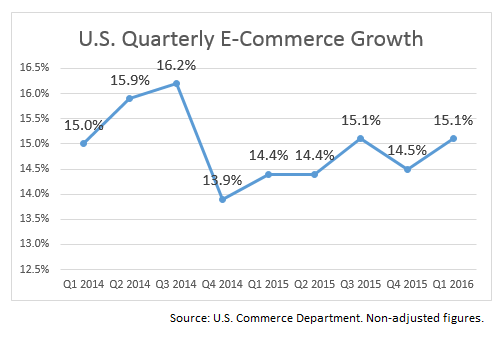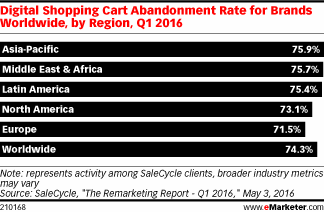Each week, we publish a mishmash of ecommerce related, insight infused articles for you to smash through. Just as we collect business information across all of a merchant’s channels in a single place, we’re doing the same for ecommerce related content from a variety of top-tier content creators. If you find the material filling your appetite for knowledge, feel free to share this post, as well as any article you see here.
The word “growth” is usually interpreted pretty positively. In the case of ecommerce, you’d be hard-pressed to argue how the industry’s rapid success is bad for e-retailers. But it does come with its drawbacks, mostly notably related to costs. As we experience consistent advancement in the world of online selling, the space is getting more congested and costly for e-retailers’ margins and rates, as well as the environment.
Proof Is in the Performance
If you aren’t convinced that ecommerce has been on the fast track of growth for years at this point, here’s some quick, recent proof. Industry performance in the first quarter of 2016 shows yet another jolt to ecommerce’s year-over-year growth rate, which hit 15.1%. Since the Great Recession, it just hasn’t slowed down. But perhaps more promising than that rate is just how much online sales accounted for total retail sales. Securing its largest share yet, online purchases made up 11.1%% of total retail sales last quarter.
The Cost of Growth
What isn’t appealing about ecommerce? For consumer and business alike, there’s a tremendous amount of benefits that’s too long to list out. That said, as ecommerce grows, it’s attracting an increasing amount of demand and competition, which is spurring a bump in costs. With more and more merchants competing for warehouse space for storage and fulfillment, providers are hiking up their fees and prices. According to an ecommerce report covered by the Wall Street Journal, price for storage near populous cities escalated by nearly 10% in 2015 alone. Who knows what’s in store for 2016.
Wary of Packed Warehouses
Well, we know what’s in store for some providers…
One of the leaders in the world of warehouses and third-party logistics, Amazon’s very own Fulfillment By Amazon (FBA) is tweaking its fees this year. It’s a highly popular service that many e-retailers, especially those selling on the marketplace, take advantage of. And as Amazon witnesses an ever-rising amount of purchases thanks in part to the growth of ecommerce as a whole, more merchants are making use of the service, leading to overcrowded warehouses.
They already know this is going to end up becoming a massive problem come the cramped 2016 holiday season when e-retailers flock to FBA for effortless fulfillment. The remedy is simple: Amazon is weeding out slow-selling products from their warehouses by raising fees. Beginning in November and ending once the holidays wrap up, FBA costs will double, forcing merchants to be much more selective about which products they decide to store with the service.
Abandonment Issues
And as traffic to online storefronts remains on the rise, those cart abandonment rates may be following the same trajectory. A high rate of abandonment is always an uwelcome sign of potentially lost revenue and poor conversion optimization, and e-retailers are constantly employing different tactics to keep those rates down, from retargeting advertisements to aggressive pop-ups. Take a look at the results of this cart abandonment study by SaleCycle to understand which of the world’s regions have the highest rates, as well as which methods are most popular for keeping them down.
USPS Fixes a Loophole
Now for the shipping carrier side of things. Remember when USPS upped their shipping rates in mid-January to compete with other carriers and pay for the booming amount of orders being fulfilled? Well, if you’re shipping lightweight packages via USPS, your margins may take a hit in August. To “correct a price anomaly” caused in January by a gap between Retail and Commercial Base, First Class, lightweight parcels rates, the USPS is planning to raise First Class mail parcel rates to $2.62 for orders that are up to three ounces. Currently, some e-retailers are benefitting from a rate ranging from $2.45 to $2.60 depending on which online postage provider they’re using.
Cardboard’s Weight on the Environment
Let’s not forgot what Mother Nature has to say about all of this. As ecommerce picks up steam at an exponential rate, our four-sided, recyclable, cardboard friends are out in full force. And, although online selling has been touted as a green way of commerce — less greenhouse gases and lower fuel costs due to less vehicles on the road — some argue that that’s simply not the case anymore thanks to the amount of people are making online purchases, the amount of vehicles fulfilling them, and the sheer volume of cardboard involved. For more, check out The New York Times’ coverage of how convenience and carboard pose a wasteful threat to our world.
Image: Flickr, Got Credit





